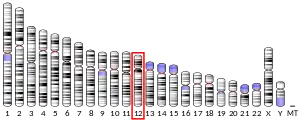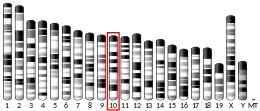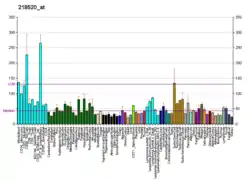TANK-binding kinase 1
TBK1 (TANK-binding kinase 1) is an enzyme with kinase activity. Specifically, it is a serine / threonine protein kinase.[5] It is encoded by the TBK1 gene in humans.[6] This kinase is mainly known for its role in innate immunity antiviral response. However, TBK1 also regulates cell proliferation, apoptosis, autophagy, and anti-tumor immunity.[5] Insufficient regulation of TBK1 activity leads to autoimmune, neurodegenerative diseases or tumorigenesis.[7][8]
Structure and regulation of activity
TBK1 is a non-canonical IKK kinase that phosphorylates the nuclear factor kB (NFkB). It shares sequence homology with canonical IKK.[5]
The N-terminus of the protein contains the kinase domain (region 9-309) and the ubiquitin-like domain (region 310-385). The C-terminus is formed by two coiled-coil structures (region 407-713) that provide a surface for homodimerization.[5][6]
The autophosphorylation of serine 172, which requires homodimerization and ubiquitinylation of lysines 30 and 401, is necessary for kinase activity.[9]
Involvement in signaling pathways
TBK1 is involved in many signaling pathways and forms a node between them. For this reason, regulation of its involvement in individual signaling pathways is necessary. This is provided by adaptor proteins that interact with the dimerization domain of TBK1 to determine its location and access to substrates. Binding to TANK leads to localization to the perinuclear region and phosphorylation of substrates which is required for subsequent production of type I interferons (IFN-I). In contrast, binding to NAP1 and SINTBAD leads to localization in the cytoplasm and involvement in autophagy. Another adaptor protein that determines the location of TBK1 is TAPE. TAPE targets TBK1 to endolysosomes.[5]
A key interest in TBK1 is due to its role in innate immunity, especially in antiviral responses. TBK1 is redundant with IKK, but TBK1 seems to play a more important role. After triggering antiviral signaling through PRRs (pattern recognition receptors), TBK1 is activated. Subsequently, it phosphorylates the transcription factor IRF3, which is translocated to the nucleus, and promotes production of IFN-I.[7]
As a non-canonical IKK, TBK1 is also involved in the non-canonical NFkB pathway. It phosphorylates p100/NF-κB2, which is subsequently processed in the proteasome and released as a p52 subunit. This subunit dimerizes with RelB and mediates gene expression.[10]
In the canonical NFkB pathway, the NF-kappa-B (NFKB) complex of proteins is inhibited by I-kappa-B (IKB) proteins, which inactivate NFKB by trapping it in the cytoplasm. Phosphorylation of serine residues on the IKB proteins by IKB kinases marks them for destruction via the ubiquitination pathway, thereby allowing activation and nuclear translocation of the NFKB complex. The protein encoded by this gene is similar to IKB kinases and can mediate NFkB activation in response to certain growth factors.[6]
TBK1 promotes autophagy involved in pathogen and mitochondrial clearance.[11] TBK1 phosphorylates autophagy receptors [12][13] and components of the autophagy apparatus.[14][15] Furthermore, TBK1 is also involved in the regulation of cell proliferation, apoptosis and glucose metabolism.[10]
Interactions
TANK-binding kinase 1 has been shown to interact with:
Transcription factors activated upon TBK1 activation include IRF3, IRF7[21] and ZEB1. [22]
Clinical significance
Deregulation of TBK1 activity and mutations in this protein are associated with many diseases. Due to the role of TBK1 in cell survival, deregulation of its activity is associated with tumorogenesis.[8] There are also many autoimmune (e.g., rheumatoid arthritis, sympathetic lupus), neurodegenerative (e.g., amyotrophic lateral sclerosis), and infantile (e.g., herpesviral encephalitis) diseases.[9][7]
The loss of TBK1 cause embryonic lethality in mice.[21]
Inhibition of IκB kinase (IKK) and IKK-related kinases, IKBKE (IKKε) and TANK-binding kinase 1 (TBK1), has been investigated as a therapeutic option for the treatment of inflammatory diseases and cancer,[23] and a way to overcome resistance to cancer immunotherapy.[24]
References
- GRCh38: Ensembl release 89: ENSG00000183735 - Ensembl, May 2017
- GRCm38: Ensembl release 89: ENSMUSG00000020115 - Ensembl, May 2017
- "Human PubMed Reference:". National Center for Biotechnology Information, U.S. National Library of Medicine.
- "Mouse PubMed Reference:". National Center for Biotechnology Information, U.S. National Library of Medicine.
- Helgason E, Phung QT, Dueber EC (April 2013). "Recent insights into the complexity of Tank-binding kinase 1 signaling networks: the emerging role of cellular localization in the activation and substrate specificity of TBK1". FEBS Letters. 587 (8): 1230–1237. doi:10.1016/j.febslet.2013.01.059. PMID 23395801.
- "Entrez Gene: TBK1 TANK-binding kinase 1".
- Louis C, Burns C, Wicks I (2018-03-06). "TANK-Binding Kinase 1-Dependent Responses in Health and Autoimmunity". Frontiers in Immunology. 9: 434. doi:10.3389/fimmu.2018.00434. PMC 5845716. PMID 29559975.
- Cruz VH, Brekken RA (March 2018). "Assessment of TANK-binding kinase 1 as a therapeutic target in cancer". Journal of Cell Communication and Signaling. 12 (1): 83–90. doi:10.1007/s12079-017-0438-y. PMC 5842199. PMID 29218456.
- Oakes JA, Davies MC, Collins MO (February 2017). "TBK1: a new player in ALS linking autophagy and neuroinflammation". Molecular Brain. 10 (1): 5. doi:10.1186/s13041-017-0287-x. PMC 5288885. PMID 28148298.
- Durand JK, Zhang Q, Baldwin AS (September 2018). "Roles for the IKK-Related Kinases TBK1 and IKKε in Cancer". Cells. 7 (9): 139. doi:10.3390/cells7090139. PMC 6162516. PMID 30223576.
- von Muhlinen N, Thurston T, Ryzhakov G, Bloor S, Randow F (February 2010). "NDP52, a novel autophagy receptor for ubiquitin-decorated cytosolic bacteria". Autophagy. 6 (2): 288–289. doi:10.4161/auto.6.2.11118. PMID 20104023. S2CID 1059428.
- Pilli M, Arko-Mensah J, Ponpuak M, Roberts E, Master S, Mandell MA, et al. (August 2012). "TBK-1 promotes autophagy-mediated antimicrobial defense by controlling autophagosome maturation". Immunity. 37 (2): 223–234. doi:10.1016/j.immuni.2012.04.015. PMC 3428731. PMID 22921120.
- Richter B, Sliter DA, Herhaus L, Stolz A, Wang C, Beli P, et al. (April 2016). "Phosphorylation of OPTN by TBK1 enhances its binding to Ub chains and promotes selective autophagy of damaged mitochondria". Proceedings of the National Academy of Sciences of the United States of America. 113 (15): 4039–4044. Bibcode:2016PNAS..113.4039R. doi:10.1073/pnas.1523926113. PMC 4839414. PMID 27035970.
- Kumar S, Gu Y, Abudu YP, Bruun JA, Jain A, Farzam F, et al. (April 2019). "Phosphorylation of Syntaxin 17 by TBK1 Controls Autophagy Initiation". Developmental Cell. 49 (1): 130–144.e6. doi:10.1016/j.devcel.2019.01.027. PMC 6907693. PMID 30827897.
- Herhaus L, Bhaskara RM, Lystad AH, Gestal-Mato U, Covarrubias-Pinto A, Bonn F, et al. (January 2020). "TBK1-mediated phosphorylation of LC3C and GABARAP-L2 controls autophagosome shedding by ATG4 protease". EMBO Reports. 21 (1): e48317. doi:10.15252/embr.201948317. PMC 6945063. PMID 31709703.
- Chou MM, Hanafusa H (March 1995). "A novel ligand for SH3 domains. The Nck adaptor protein binds to a serine/threonine kinase via an SH3 domain". The Journal of Biological Chemistry. 270 (13): 7359–7364. doi:10.1074/jbc.270.13.7359. PMID 7706279.
- Pomerantz JL, Baltimore D (December 1999). "NF-kappaB activation by a signaling complex containing TRAF2, TANK and TBK1, a novel IKK-related kinase". The EMBO Journal. 18 (23): 6694–6704. doi:10.1093/emboj/18.23.6694. PMC 1171732. PMID 10581243.
- Bouwmeester T, Bauch A, Ruffner H, Angrand PO, Bergamini G, Croughton K, et al. (February 2004). "A physical and functional map of the human TNF-alpha/NF-kappa B signal transduction pathway". Nature Cell Biology. 6 (2): 97–105. doi:10.1038/ncb1086. PMID 14743216. S2CID 11683986.
- Bonnard M, Mirtsos C, Suzuki S, Graham K, Huang J, Ng M, et al. (September 2000). "Deficiency of T2K leads to apoptotic liver degeneration and impaired NF-kappaB-dependent gene transcription". The EMBO Journal. 19 (18): 4976–4985. doi:10.1093/emboj/19.18.4976. PMC 314216. PMID 10990461.
- "TANK-binding kinase 1-binding protein 1". UniProt. Retrieved 30 Jun 2018.
- Ikeda F, Hecker CM, Rozenknop A, Nordmeier RD, Rogov V, Hofmann K, et al. (July 2007). "Involvement of the ubiquitin-like domain of TBK1/IKK-i kinases in regulation of IFN-inducible genes". The EMBO Journal. 26 (14): 3451–3462. doi:10.1038/sj.emboj.7601773. PMC 1933404. PMID 17599067.
- Liu W, Huang YJ, Liu C, Yang YY, Liu H, Cui JG, et al. (April 2014). "Inhibition of TBK1 attenuates radiation-induced epithelial-mesenchymal transition of A549 human lung cancer cells via activation of GSK-3β and repression of ZEB1". Laboratory Investigation; A Journal of Technical Methods and Pathology. 94 (4): 362–370. doi:10.1038/labinvest.2013.153. PMID 24468793.
- Llona-Minguez S, Baiget J, Mackay SP (July 2013). "Small-molecule inhibitors of IκB kinase (IKK) and IKK-related kinases". Pharmaceutical Patent Analyst. 2 (4): 481–498. doi:10.4155/ppa.13.31. PMID 24237125.
- Sun, Y.; Anderson, S. (January 12, 2023). "Targeting TBK1 to overcome resistance to cancer immunotherapy". Nature. doi:10.1038/s41586-023-05704-6. PMID 36634707.
Further reading
- Chou MM, Hanafusa H (March 1995). "A novel ligand for SH3 domains. The Nck adaptor protein binds to a serine/threonine kinase via an SH3 domain". The Journal of Biological Chemistry. 270 (13): 7359–7364. doi:10.1074/jbc.270.13.7359. PMID 7706279.
- Chen ZJ, Parent L, Maniatis T (March 1996). "Site-specific phosphorylation of IkappaBalpha by a novel ubiquitination-dependent protein kinase activity". Cell. 84 (6): 853–862. doi:10.1016/S0092-8674(00)81064-8. PMID 8601309. S2CID 112412.
- Zandi E, Chen Y, Karin M (August 1998). "Direct phosphorylation of IkappaB by IKKalpha and IKKbeta: discrimination between free and NF-kappaB-bound substrate". Science. 281 (5381): 1360–1363. doi:10.1126/science.281.5381.1360. PMID 9721103.
- Bonnard M, Mirtsos C, Suzuki S, Graham K, Huang J, Ng M, et al. (September 2000). "Deficiency of T2K leads to apoptotic liver degeneration and impaired NF-kappaB-dependent gene transcription". The EMBO Journal. 19 (18): 4976–4985. doi:10.1093/emboj/19.18.4976. PMC 314216. PMID 10990461.
- Kishore N, Huynh QK, Mathialagan S, Hall T, Rouw S, Creely D, et al. (April 2002). "IKK-i and TBK-1 are enzymatically distinct from the homologous enzyme IKK-2: comparative analysis of recombinant human IKK-i, TBK-1, and IKK-2". The Journal of Biological Chemistry. 277 (16): 13840–13847. doi:10.1074/jbc.M110474200. PMID 11839743.
- Chariot A, Leonardi A, Muller J, Bonif M, Brown K, Siebenlist U (October 2002). "Association of the adaptor TANK with the I kappa B kinase (IKK) regulator NEMO connects IKK complexes with IKK epsilon and TBK1 kinases". The Journal of Biological Chemistry. 277 (40): 37029–37036. doi:10.1074/jbc.M205069200. PMID 12133833.
- Li SF, Fujita F, Hirai M, Lu R, Niida H, Nakanishi M (January 2003). "Genomic structure and characterization of the promoter region of the human NAK gene". Gene. 304: 57–64. doi:10.1016/S0378-1119(02)01179-4. PMID 12568715.
- Fitzgerald KA, McWhirter SM, Faia KL, Rowe DC, Latz E, Golenbock DT, et al. (May 2003). "IKKepsilon and TBK1 are essential components of the IRF3 signaling pathway". Nature Immunology. 4 (5): 491–496. doi:10.1038/ni921. PMID 12692549. S2CID 19867234.
- Sharma S, tenOever BR, Grandvaux N, Zhou GP, Lin R, Hiscott J (May 2003). "Triggering the interferon antiviral response through an IKK-related pathway". Science. 300 (5622): 1148–1151. Bibcode:2003Sci...300.1148S. doi:10.1126/science.1081315. PMID 12702806. S2CID 42641584.
- Matsuda A, Suzuki Y, Honda G, Muramatsu S, Matsuzaki O, Nagano Y, et al. (May 2003). "Large-scale identification and characterization of human genes that activate NF-kappaB and MAPK signaling pathways". Oncogene. 22 (21): 3307–3318. doi:10.1038/sj.onc.1206406. PMID 12761501.
- Sato S, Sugiyama M, Yamamoto M, Watanabe Y, Kawai T, Takeda K, Akira S (October 2003). "Toll/IL-1 receptor domain-containing adaptor inducing IFN-beta (TRIF) associates with TNF receptor-associated factor 6 and TANK-binding kinase 1, and activates two distinct transcription factors, NF-kappa B and IFN-regulatory factor-3, in the Toll-like receptor signaling". Journal of Immunology. 171 (8): 4304–4310. doi:10.4049/jimmunol.171.8.4304. PMID 14530355.
- Fujita F, Taniguchi Y, Kato T, Narita Y, Furuya A, Ogawa T, et al. (November 2003). "Identification of NAP1, a regulatory subunit of IkappaB kinase-related kinases that potentiates NF-kappaB signaling". Molecular and Cellular Biology. 23 (21): 7780–7793. doi:10.1128/MCB.23.21.7780-7793.2003. PMC 207563. PMID 14560022.
- Bouwmeester T, Bauch A, Ruffner H, Angrand PO, Bergamini G, Croughton K, et al. (February 2004). "A physical and functional map of the human TNF-alpha/NF-kappa B signal transduction pathway". Nature Cell Biology. 6 (2): 97–105. doi:10.1038/ncb1086. PMID 14743216. S2CID 11683986.
- tenOever BR, Sharma S, Zou W, Sun Q, Grandvaux N, Julkunen I, et al. (October 2004). "Activation of TBK1 and IKKvarepsilon kinases by vesicular stomatitis virus infection and the role of viral ribonucleoprotein in the development of interferon antiviral immunity". Journal of Virology. 78 (19): 10636–10649. doi:10.1128/JVI.78.19.10636-10649.2004. PMC 516426. PMID 15367631.
- Kuai J, Wooters J, Hall JP, Rao VR, Nickbarg E, Li B, et al. (December 2004). "NAK is recruited to the TNFR1 complex in a TNFalpha-dependent manner and mediates the production of RANTES: identification of endogenous TNFR-interacting proteins by a proteomic approach". The Journal of Biological Chemistry. 279 (51): 53266–53271. doi:10.1074/jbc.M411037200. PMID 15485837.
- Buss H, Dörrie A, Schmitz ML, Hoffmann E, Resch K, Kracht M (December 2004). "Constitutive and interleukin-1-inducible phosphorylation of p65 NF-κB at serine 536 is mediated by multiple protein kinases including IκB kinase IKK-α, IKK-β, IKK-ε, TRAF family member-associated (TANK)-binding kinase 1 (TBK1), and an unknown kinase and couples p65 to TATA-binding protein-associated factor II31-mediated interleukin-8 transcription". The Journal of Biological Chemistry. 279 (53): 55633–55643. doi:10.1074/jbc.M409825200. PMID 15489227.





